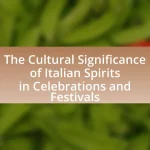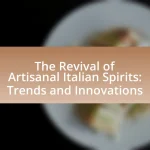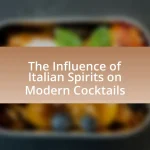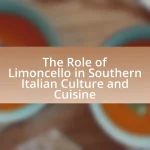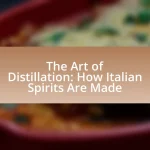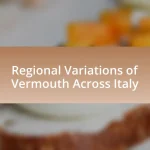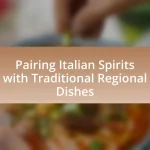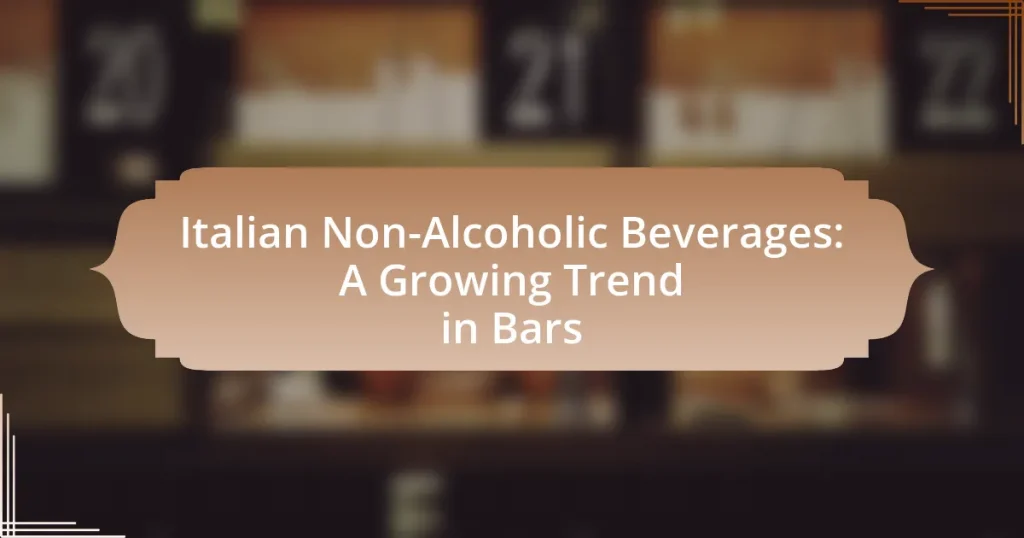Italian non-alcoholic beverages are a diverse range of drinks popular in Italy, characterized by their unique flavors and cultural significance. This article explores the growing trend of these beverages in bars, highlighting their differences from traditional alcoholic options, common ingredients, and preparation methods. It examines the increasing consumer demand for healthier lifestyle choices and social inclusivity, as well as the role of these beverages in enhancing dining experiences. Additionally, the article discusses the challenges bars face in sourcing and serving non-alcoholic options, along with effective strategies for successful integration into their menus.
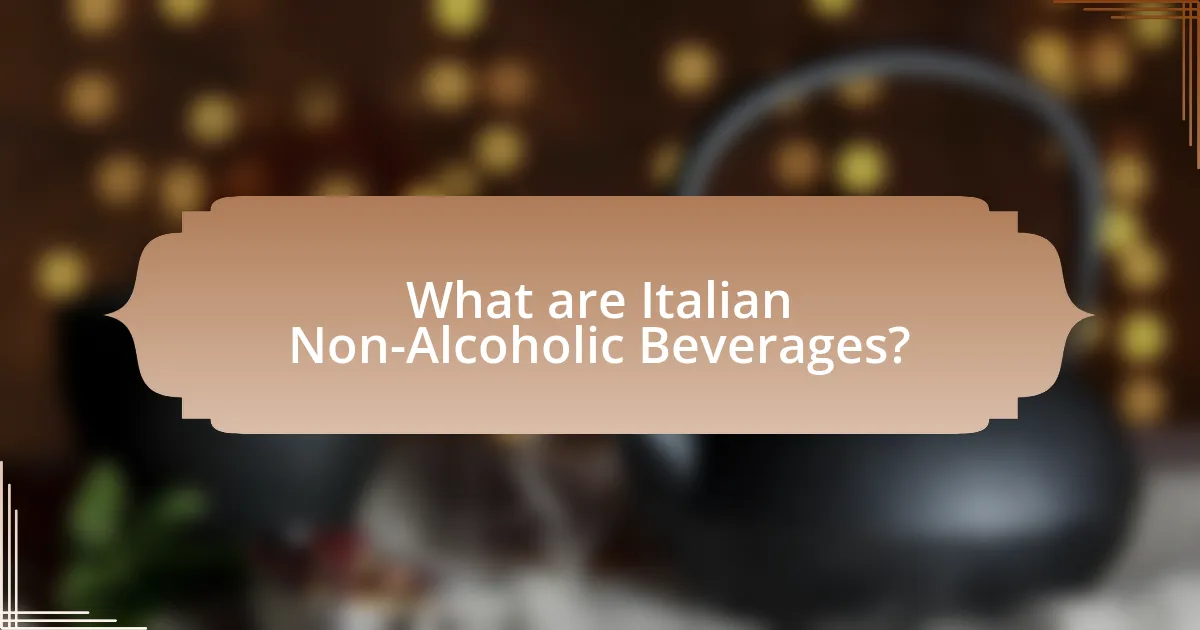
What are Italian Non-Alcoholic Beverages?
Italian non-alcoholic beverages are drinks that do not contain alcohol and are popular in Italy, often enjoyed for their unique flavors and cultural significance. These beverages include options such as Italian sodas, fruit juices, herbal teas, and non-alcoholic versions of traditional cocktails like the Negroni or Spritz. The growing trend in bars reflects a shift towards inclusivity, allowing individuals who prefer not to consume alcohol to enjoy sophisticated and flavorful drink options. This trend is supported by the increasing demand for healthier lifestyle choices and the desire for social experiences without alcohol.
How do Italian Non-Alcoholic Beverages differ from traditional beverages?
Italian non-alcoholic beverages differ from traditional beverages primarily in their flavor profiles and ingredients, often emphasizing fresh, natural components over artificial additives. For instance, Italian non-alcoholic options like aperitifs are crafted with herbs, spices, and fruits, creating complex flavors that mimic the experience of alcoholic drinks without the alcohol content. This trend is supported by the increasing demand for sophisticated non-alcoholic alternatives in bars, reflecting a cultural shift towards healthier and more inclusive drinking options.
What ingredients are commonly used in Italian Non-Alcoholic Beverages?
Common ingredients in Italian non-alcoholic beverages include sparkling water, fruit juices, herbs, and syrups. Sparkling water serves as a base for many drinks, providing a refreshing effervescence. Fruit juices, such as orange, lemon, and pomegranate, add natural sweetness and flavor. Herbs like basil and mint are often used for aromatic enhancement, while syrups, particularly those made from fruits or flowers, contribute additional sweetness and complexity. These ingredients reflect traditional Italian flavors and are integral to the growing trend of non-alcoholic options in bars.
How are these beverages traditionally prepared and served?
Italian non-alcoholic beverages are traditionally prepared using fresh, high-quality ingredients and served in specific ways that enhance their flavors. For example, Italian sodas are made by mixing flavored syrups with carbonated water, often served over ice in a tall glass, garnished with fruit or herbs for added aroma and visual appeal. Similarly, drinks like Caffè d’Orzo, a barley coffee, are brewed using a coffee maker and served hot or cold, typically in a small cup. The preparation methods emphasize simplicity and freshness, reflecting Italy’s culinary traditions.
Why is there a growing interest in Italian Non-Alcoholic Beverages?
There is a growing interest in Italian non-alcoholic beverages due to increasing consumer demand for healthier lifestyle choices and the rise of mindful drinking trends. This shift is evidenced by a 2022 report from the IWSR, which indicates that the non-alcoholic beverage market is projected to grow by 31% globally by 2024. Italian brands are capitalizing on this trend by offering high-quality, flavorful alternatives that appeal to both alcohol consumers and those seeking non-alcoholic options. The unique flavors and cultural heritage associated with Italian beverages further enhance their appeal, making them a popular choice in bars and restaurants.
What cultural factors contribute to the popularity of these beverages?
Cultural factors contributing to the popularity of Italian non-alcoholic beverages include the increasing emphasis on health and wellness, social inclusivity, and the rich tradition of Italian culinary culture. The health trend has led consumers to seek alternatives to alcoholic drinks, with beverages like Italian sodas and non-alcoholic aperitifs gaining traction. Social inclusivity is also significant, as these beverages allow individuals who abstain from alcohol to participate in social gatherings without feeling excluded. Furthermore, Italy’s culinary heritage, which celebrates flavors and quality ingredients, enhances the appeal of these beverages, making them a desirable choice in bars and restaurants. The combination of these cultural influences drives the growing trend of non-alcoholic options in the Italian beverage market.
How do health trends influence consumer choices regarding non-alcoholic options?
Health trends significantly influence consumer choices regarding non-alcoholic options by driving demand for healthier alternatives. As awareness of health issues such as obesity and alcohol-related diseases increases, consumers are increasingly opting for non-alcoholic beverages that are perceived as healthier, such as low-calorie drinks, functional beverages, and those with natural ingredients. For instance, a report by the International Wine and Spirits Record indicates that the non-alcoholic beverage market has grown by 33% in the past five years, reflecting a shift in consumer preferences towards wellness-oriented products. This trend is particularly evident in bars, where the availability of sophisticated non-alcoholic options caters to health-conscious patrons seeking enjoyable alternatives without compromising their health goals.
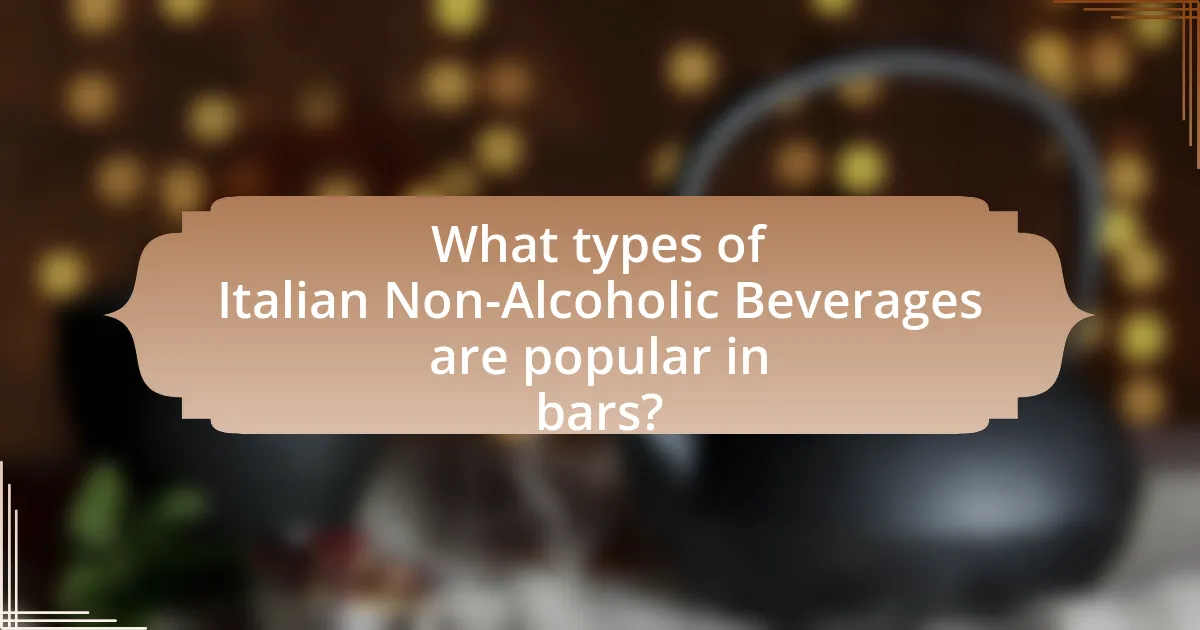
What types of Italian Non-Alcoholic Beverages are popular in bars?
Popular Italian non-alcoholic beverages in bars include Italian sodas, San Pellegrino sparkling water, and various fruit juices like aranciata (orange soda) and limonata (lemon soda). Italian sodas are often flavored with syrups and served with fresh fruit, making them a refreshing choice. San Pellegrino sparkling water is widely consumed for its crisp taste and is often paired with meals. Additionally, aranciata and limonata are traditional favorites, known for their vibrant flavors and are commonly enjoyed as alternatives to alcoholic drinks. These beverages reflect Italy’s rich culinary culture and are increasingly favored in social settings.
Which specific beverages are gaining traction in the bar scene?
Italian non-alcoholic beverages, particularly aperitifs like non-alcoholic spritzes and botanical-infused drinks, are gaining traction in the bar scene. The rise in health-conscious consumer behavior has led to an increased demand for sophisticated non-alcoholic options, with brands like Seedlip and Lyre’s offering complex flavors that mimic traditional cocktails. According to a report by IWSR, the non-alcoholic beverage market is projected to grow by 31% by 2024, indicating a significant shift in consumer preferences towards these innovative drinks.
What are the characteristics of popular Italian sodas and juices?
Popular Italian sodas and juices are characterized by their vibrant flavors, natural ingredients, and often a refreshing effervescence. These beverages typically feature fruit-based flavors such as blood orange, lemon, and grapefruit, which are derived from high-quality, locally sourced fruits. Additionally, many Italian sodas are lightly carbonated, providing a crisp and refreshing drinking experience. The use of natural sweeteners, such as cane sugar or fruit extracts, is common, enhancing the authentic taste without artificial additives. This focus on quality and tradition reflects Italy’s culinary heritage, making these beverages a popular choice in bars and restaurants.
How do Italian mocktails compare to their alcoholic counterparts?
Italian mocktails offer a similar flavor profile and presentation to their alcoholic counterparts but lack the intoxicating effects of alcohol. These non-alcoholic beverages often utilize the same ingredients as traditional cocktails, such as fresh fruits, herbs, and mixers, allowing for a comparable taste experience. For instance, a mocktail version of a classic Negroni uses non-alcoholic spirits to replicate the original’s bitterness and complexity. This trend reflects a growing demand for inclusive drinking options, as evidenced by a 2021 report from the International Wines and Spirits Record, which noted a 30% increase in non-alcoholic beverage sales in Italy.
What role do Italian Non-Alcoholic Beverages play in social settings?
Italian non-alcoholic beverages serve as essential social facilitators in various settings, enhancing interactions and experiences among individuals. These beverages, such as Italian sodas, aperitifs, and sparkling waters, are often enjoyed during gatherings, meals, and celebrations, providing a sophisticated alternative to alcoholic drinks. Their popularity is evidenced by the increasing presence of these beverages in bars and restaurants, reflecting a cultural shift towards inclusivity and health-conscious choices. This trend is supported by market research indicating a significant rise in demand for non-alcoholic options, with a reported 30% increase in sales over the past few years, highlighting their growing role in socializing without alcohol.
How do these beverages enhance the dining experience in bars?
Italian non-alcoholic beverages enhance the dining experience in bars by providing flavorful and sophisticated alternatives to traditional alcoholic drinks. These beverages, such as Italian sodas and non-alcoholic aperitifs, cater to a growing demographic seeking enjoyable social experiences without alcohol. Their unique flavors and high-quality ingredients elevate the overall beverage selection, making the dining experience more inclusive and appealing. For instance, the rise of non-alcoholic options has been supported by market research indicating that 27% of consumers are reducing their alcohol intake, highlighting the demand for diverse beverage choices that enhance social interactions while accommodating various preferences.
What are the social implications of offering non-alcoholic options in bars?
Offering non-alcoholic options in bars promotes inclusivity and caters to a broader audience, including those who abstain from alcohol for health, religious, or personal reasons. This shift encourages social interaction among diverse groups, reducing the stigma associated with not drinking alcohol. Research indicates that 29% of adults in the U.S. are choosing non-alcoholic beverages, reflecting a growing trend towards mindful drinking and healthier lifestyles. By providing these options, bars can enhance customer satisfaction and loyalty, ultimately leading to increased patronage and revenue.
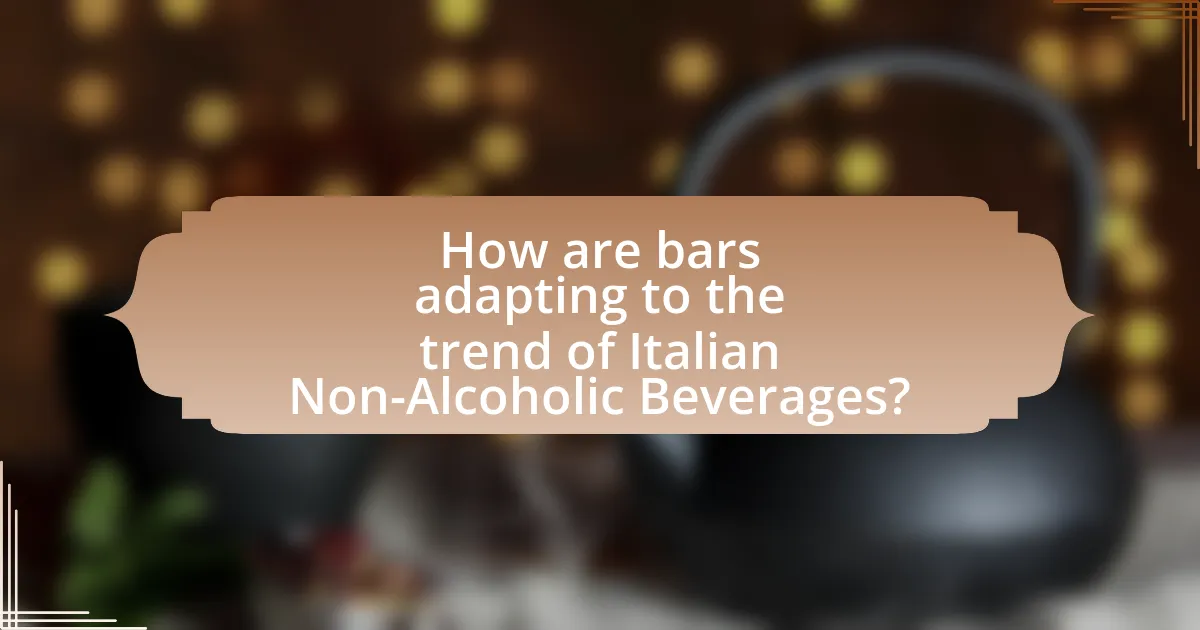
How are bars adapting to the trend of Italian Non-Alcoholic Beverages?
Bars are adapting to the trend of Italian non-alcoholic beverages by incorporating a diverse range of these drinks into their menus, offering options like Italian sodas, non-alcoholic aperitifs, and craft mocktails. This shift is driven by the increasing consumer demand for healthier alternatives, as evidenced by a report from IWSR Drinks Market Analysis, which indicates a 31% growth in the non-alcoholic beverage sector in Italy from 2019 to 2022. Additionally, bars are enhancing the presentation and experience of these beverages to appeal to patrons seeking sophisticated non-alcoholic options, thereby aligning with the broader trend of mindful drinking.
What strategies are bars implementing to incorporate these beverages?
Bars are implementing strategies such as creating dedicated non-alcoholic beverage menus and offering innovative mocktails to incorporate Italian non-alcoholic beverages. These strategies cater to the increasing demand for alcohol-free options, with a focus on high-quality ingredients and unique flavor profiles that reflect traditional Italian beverages. For instance, bars are using artisanal sodas and non-alcoholic aperitifs, which have seen a 30% increase in sales in recent years, demonstrating a shift in consumer preferences towards sophisticated non-alcoholic choices.
How are bartenders trained to create non-alcoholic cocktails?
Bartenders are trained to create non-alcoholic cocktails through a combination of formal education, hands-on experience, and specialized workshops. Training programs often include courses on mixology that cover flavor profiles, ingredient selection, and presentation techniques specifically for non-alcoholic beverages. Additionally, bartenders may participate in workshops focused on the growing trend of non-alcoholic cocktails, where they learn to balance flavors and create appealing presentations without alcohol. This training is supported by the increasing demand for non-alcoholic options in bars, reflecting a shift in consumer preferences towards healthier choices.
What marketing techniques are effective for promoting Italian Non-Alcoholic Beverages?
Effective marketing techniques for promoting Italian non-alcoholic beverages include leveraging social media campaigns, influencer partnerships, and experiential marketing events. Social media platforms like Instagram and Facebook allow brands to showcase visually appealing content, engaging potential customers through targeted ads and organic posts. Influencer partnerships can amplify reach, as influencers often have dedicated followings that trust their recommendations, making them effective in promoting new beverage options. Experiential marketing events, such as tastings or pop-up bars, create immersive experiences that allow consumers to sample products firsthand, fostering brand loyalty and encouraging word-of-mouth promotion. These techniques are supported by the growing trend of health-conscious consumers seeking flavorful non-alcoholic alternatives, as evidenced by a 2022 report from IWSR, which noted a 31% increase in non-alcoholic beverage sales globally.
What challenges do bars face when introducing Italian Non-Alcoholic Beverages?
Bars face several challenges when introducing Italian non-alcoholic beverages, primarily related to consumer perception, supply chain logistics, and staff training. Consumer perception can be a significant hurdle, as many patrons may associate non-alcoholic options with lower quality or lack of flavor, which can deter them from trying these beverages. Additionally, sourcing authentic Italian non-alcoholic beverages can be complicated due to limited availability and the need for reliable suppliers, which can affect inventory management and pricing strategies. Furthermore, staff training is essential to ensure that bartenders can effectively promote and serve these beverages, as a lack of knowledge can lead to missed sales opportunities. These challenges highlight the complexities bars must navigate to successfully integrate Italian non-alcoholic beverages into their offerings.
How can bars overcome resistance from traditional customers?
Bars can overcome resistance from traditional customers by introducing Italian non-alcoholic beverages that appeal to their tastes while providing a familiar experience. By offering high-quality, flavorful alternatives like Italian sodas or non-alcoholic aperitifs, bars can attract traditional customers who may be hesitant to try new options. Research indicates that 66% of consumers are interested in non-alcoholic beverages, suggesting a significant market potential. Additionally, bars can create a welcoming atmosphere by incorporating these beverages into their menus alongside traditional offerings, thus easing the transition for customers.
What logistical issues arise in sourcing and serving these beverages?
Logistical issues in sourcing and serving Italian non-alcoholic beverages include supply chain disruptions, storage requirements, and distribution challenges. Supply chain disruptions can arise from limited availability of specific ingredients or products, particularly those that are regionally sourced in Italy, leading to delays in procurement. Storage requirements are critical, as many non-alcoholic beverages may require refrigeration or specific conditions to maintain quality, complicating inventory management. Distribution challenges can occur due to the need for timely delivery to bars, which may involve coordinating with multiple suppliers and ensuring that products arrive in optimal condition. These factors collectively impact the efficiency and effectiveness of sourcing and serving these beverages in a bar setting.
What are the best practices for bars to successfully offer Italian Non-Alcoholic Beverages?
Bars should focus on sourcing authentic Italian non-alcoholic beverages, such as Italian sodas, aperitifs, and sparkling waters, to successfully cater to this growing trend. Establishing partnerships with reputable Italian beverage distributors ensures quality and authenticity, which is crucial for attracting customers seeking genuine Italian experiences. Additionally, bars should create a dedicated menu section for these beverages, highlighting their unique flavors and origins, which can enhance customer interest and engagement. Training staff to understand and recommend these beverages effectively can further improve customer experience and sales. Offering tastings or pairing suggestions with food can also encourage patrons to explore these options, thereby increasing overall beverage sales.
